A few weeks ago, while running our 5-day central Vietnam photography tour, we had the pleasure to welcome again Janet Powick. This year was Janet’s fourth participation in our photography workshops in Vietnam, a few times in central Vietnam as well as a trip to the mountains of North Vietnam. I believe Janet keeps coming back because she enjoys the teachings in our photography tours as well as the very relaxed atmosphere we create, ideal for an Australian lady from the outback!
This year, Janet has been blowing every participant’s minds! She recently started to experiment with ICM (Intentional Camera Movement) with landscapes in Australia. For Janet, this recent trip to Vietnam was a way to see how she could apply this technique to people photography. The work she showed us during our last photo review was so interesting that I asked her if I could interview her to showcase the work on Pics of Asia.
I believe this can help you improve your creativity and think in different ways when capturing a scene. Her painterly looking photos are a fresh and inspiring change.
All images are Copyrighted @ Janet Powick.
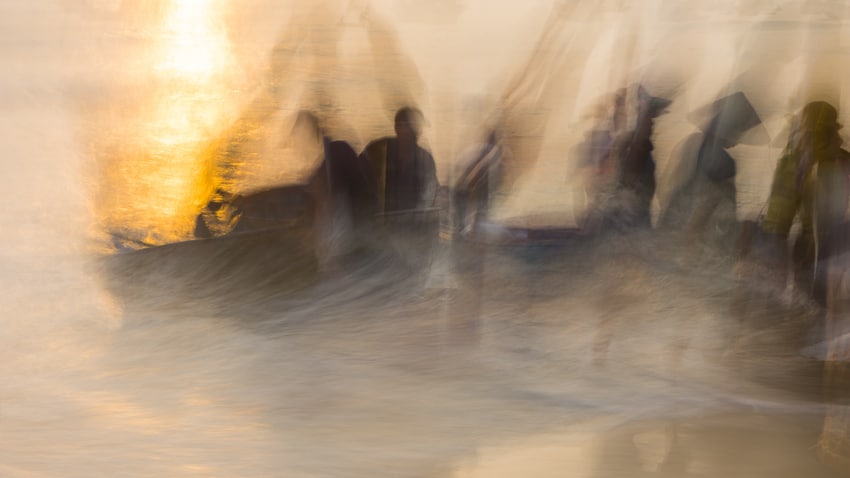
POA: “Can you please introduce yourself?”
Jan Powick (JP): “I am an amateur photographer living at Rum Jungle, Northern Territory, Australia. As a retiree, I have the time and inclination to dabble in all genres of photography, but I particularly enjoy the solitude of landscape photography. Since the beginning of this year, ICM has become my style and passion for photography. I have been spending a lot of time experimenting with it and have made a commitment to myself to develop and publish a body of work using this technique. Etienne’s Central Vietnam Tour seemed a great opportunity to further experiment with this technique.”
Poa: “Why did you start doing that/ and why?”
I really started doing ICM (Intentional Camera Movement) seriously by accident. I had gone out to the local National Park during the wet season to shoot waterfalls. When I got to my spot and set up my tripod I realised I didn’t have my quick release plate. This put an abrupt end to long exposure waterfalls. Instead of heading home dejected, I decided to head to, a paperbark swamp (Melaleuca trees)and play with my ND filters. Hence began my adventure and addiction to ICM.
Fortunately, there was also another paperbark swamp 5 minutes from home so I went there often. Every time there was a change in the weather, I thought, “ I wonder what the swamps will look like today?” and out I would go.”
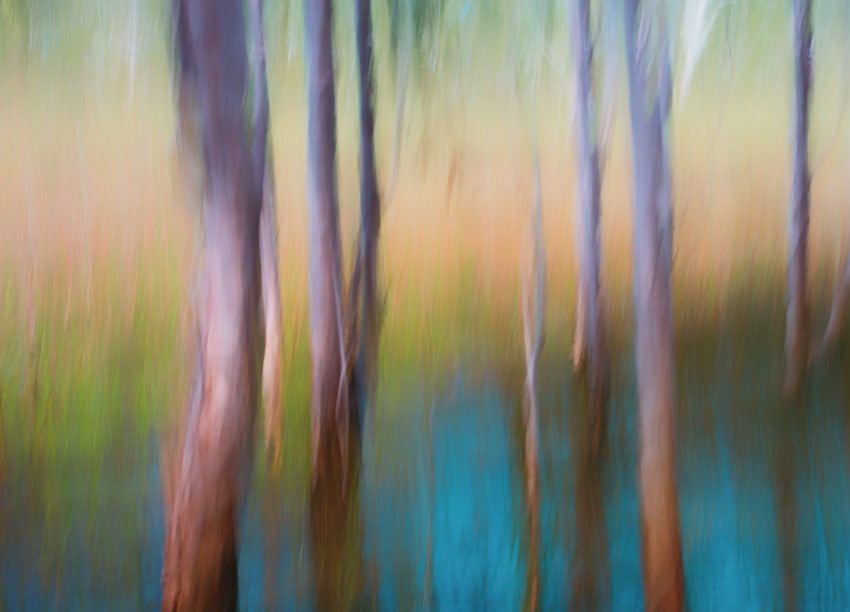
Poa: “What effect are you looking for when doing this, or is it more like experiments?”
For me, ICM photography, is a move away from the reality of a sort of documentary style photo, to a more impressionistic or abstract style. The resulting image has a much more painterly feel about it. There is less detail in the image, it often has a softer feel and it can often capture the true atmosphere of the place. Strong lines and the blending of the colours can produce amazing painterly effects and people and objects become recognisable only by their outline. ICM can add an artistic and timeless feel to the image.
Poa: “Was it difficult for you to switch your technique from trees to people?”
Trees are stationary, vertical objects and people, boats and waves are moving. While the vertical pan was successful for trees in a swamp it was not as reliable for getting creative shots of Vietnamese people at work. In Vietnam, I started experimenting with a variety of panning techniques:- horizontal, zig-zag, jiggling and bringing it back towards me in a horizontal movement. The hustle and bustle of the people are quintessential to capturing the atmosphere of the different places of work in Vietnam. I still consider myself a novice with ICM in Central Vietnam because I haven’t practised all these other panning techniques many, many times as I did in the paperbark swamps. I would definitely like to return to the same places in Vietnam and continue to get some really creative images which express the true character of Central Vietnam.”
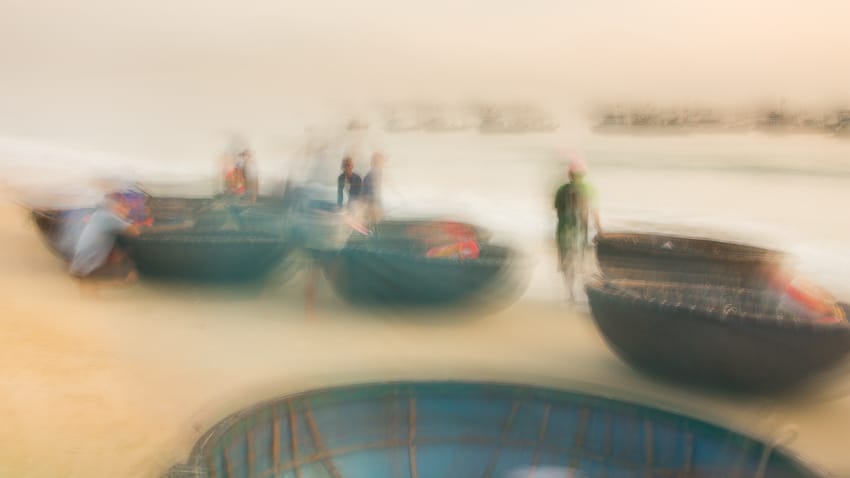
Poa: “Can you describe your typical process?”
I take a lot of photos and look at the screen to gauge whether anything looks exciting or not. If it has potential, I repeat the process several times, with slight changes of movement to try and improve the effect. I tried different shutter speeds, but still, prefer shutter speeds between 1 and 2 seconds.
At first, I was just playing and experimenting to see what sort of effects I could get. My first efforts used a 2-second vertical movement with an ND 64 filter. This produced some very colourful and creative effects and so I decided to try and perfect my technique. I refined it further by using my camera strap as my tripod so that the movement was much more controlled and even. The technique I was using differed in 2 ways from material I had found online. Firstly, most of the instructions online on ICM recommend shutter speeds of less than 1 second, more often 1/15 – ½ a second. Secondly, focusing was important to the creation of my images whereas some photographers thought it was not that important.
I found that the 2 seconds gave my photos a painterly look. There were all sorts of beautiful colours that could emerge during post-processing, depending on whether it was a dark stormy day, a cloudy dull day or on rare occasions a sunny day. The contrast between the tall green grass (gamba and spear ) and the colours of the bark created some amazing effects. Paperbark trees have multicoloured peeling bark of all shades of red-brown, cream, black, grey and under some conditions a purple tint. The water in the swamp added an artistic feel to the images. Later, I added a polarising filter which cut down a lot of the glare from the water. My biggest enemy was the sky and particularly the clouds as they became over-exposed. For this reason, I found it more successful to pan down rather than up. Sometimes I tried a shaking motion and this gave a sort of Monet look to the trees.
The advantage of going back to the same places over and over again meant that I could process photos, critique them and then go back and try to make a better image by tweaking the process or including other elements.”
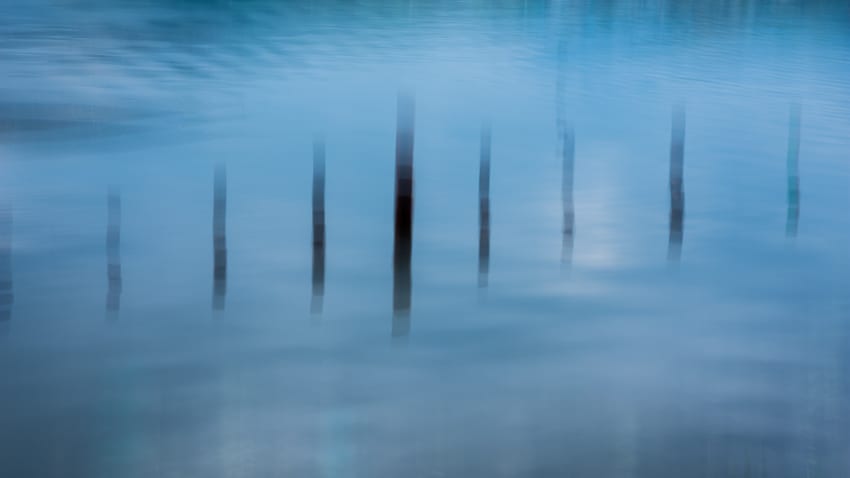
Poa: “What are the main difficulties when doing this?”
ICM is always a bit of hit and mostly miss. But every now and then an image jumps out and encourages me to keep at it. The problem with a photo tour is that I can’t go back to the same place the next day, and the day after, and try to improve on my techniques and composition.
Poa: “Do you have any tips for anyone who wants to try?”
1. Don’t expect to become an expert in 5 minutes. Practice, practice and more practice. Expect your keeper rate to be very low.
2. Experiment with shutter speeds and ND filters to find a movement that suits you. Once you find a shutter speed you like to stick to it for a while and gain proficiency.
3. Choose one type of panning that suits you Repeat it over and over again until you can get a smooth, semi-predictable outcome. Then try and master a different pan. Although I haven’t used one, a tripod might be a good way to start, because the movements would be smoother.
4. Look for contrasting colours and good composition. Cropping often improves the image and gets rid of overexposed skies.
5. Use post-processing software like Lightroom. For trees, I sometimes used Color Effex Pro (Nik Collection). The filters and blending modes in Photoshop might produce artistic effects that you are after.
6. Search the internet for ideas on ICM.
a. Doug Chinnery has a 3 part webinar on ICM
b. Kathleen Clemons has a class on Creativelive entitled “ Creating Painterly Photographs.”
7. Beware it can be addictive!
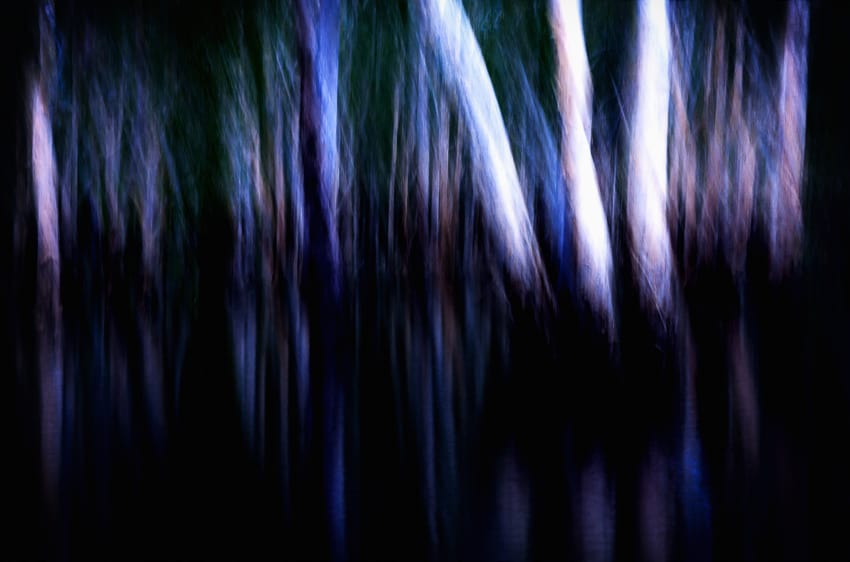

Well what a fantastic five day tour for my wife and I. The amazing venues from sunrise boat trips, landscape on the plains and in the mountains, and street photography both in the street and in closer areas. One of the great things was the fact that the organisers took us to places where people were happy to see us and were happy to have their photographs taken.
What a great experience and I look forward to the next trip.
It was great working with Jan both on and off the tour, her photographs are amazing and with her intentional movement photography she is developing a style which will go global!
Many thanks,
David
Thanks for the kind words David, I am sure Janet is super excited about inspiring people around her!
Thank you for this great interview. I have recently discovered the joys of ICM and have been searching the internet for hints and tips. I was really interested to hear Jan say she uses a shutter speed of between 1 – 2 seconds. I too was under the impression that shooting between 0.25 – 1.00 second is the way to go. You have inspired me Jan to get out there and practice!
Thanks Gill. The shutter speed you are using depends mostly on the subject you are trying to capture (like, for example, when doing panning) and how fast you intend to move your camera. It is about trial and experimenting, and the journey is fun! Keep shooting 🙂